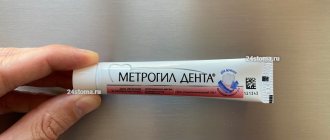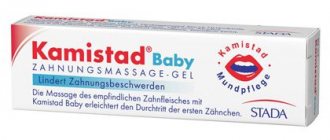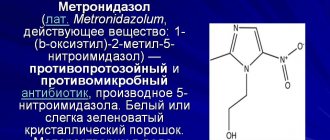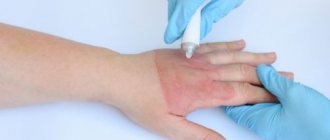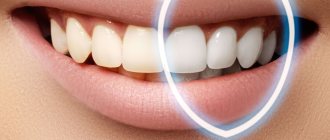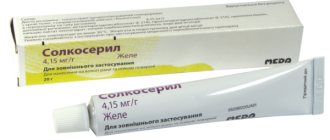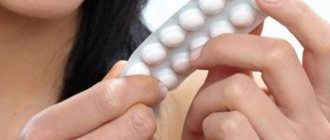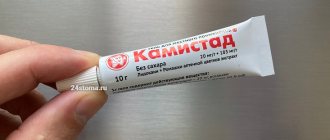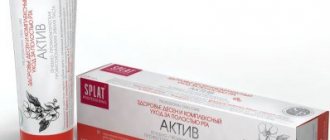pharmachologic effect
Manufacturer: Unique Pharmaceutical Laboratories, India
Release form: dental gel
Active ingredient: chlorhexidine, metronidazole
Synonyms: Metrodent, Dentamet
Metrogyl Denta is a combined agent that exhibits antimicrobial, cooling and weak local anesthetic effects. This gel effect is due to the components included in the composition.
Chlorhexidine is an antiseptic substance that exhibits a bactericidal effect and is active against bacteria and some viruses.
Metronidazole is an antiprotozoal and antimicrobial substance that is active against anaerobic bacteria.
Levomenthol is an auxiliary component that exhibits local analgesic and anti-inflammatory effects.
Metrogyl Denta - instructions for use
According to the instructions for use, Metrogyl Denta gel is used topically in adults and children over 6 years of age.
The dosage regimen of the medication depends on the patient’s condition:
- For stomatitis, the drug is applied 2 times a day for 7–10 days.
- For gingivitis, the medicine is applied to the gums 2 times a day for 7–10 days.
- In case of inflammation of the tissues around the tooth, the drug is applied in a thin layer twice a day. The course of treatment is 1–2 weeks.
- After tooth extraction, the medication is placed in the hole 2-3 times a day. Treatment continues for 7 days.
- As a prophylaxis for chronic gum inflammation, apply twice a day for 10 days. Such prevention is carried out once every six months.
After applying the drug, do not eat or drink for 30 minutes.
The drug "Klion"
Another analogue in tablet form is Metrogyl. This analogue can be purchased at absolutely any pharmacy, paying only a little more than sixty rubles for it. And the name of this analogue is “Klion”. Many people have probably heard the name of this medicine more than once. Television and radio advertise this product with might and main. What is this remedy?
It’s worth starting with the fact that the manufacturers of this drug produce Klion in two forms - tablets and solution. Tablets, as mentioned above, are cheap, but the solution will cost the buyer one hundred rubles. As the manufacturer promises, the effect of this drug will not take long to appear.
As for taking this medicine, the following can be said about this. "Klion" is used either during a meal or immediately after a meal. The duration of the entire course depends on the disease that the patient has. Basically, the course is ten or five days. The only thing that can be added is that this drug is prescribed to children only after two years of age.
The solution is administered intravenously using a regular dropper. The dose of the drug is calculated solely based on the patient’s body weight.
Before use, be sure to consult your doctor. After all, he is the one who will prescribe exactly the right dose of the drug “Klion” that the patient definitely needs.
This is all that can be said about this medicine. It is in no way inferior to the drug Metrogyl. Perhaps in some moments it even wins. But whether to buy this product or not is, of course, up to the buyer himself.
Metrogil Dent's analogs
For the treatment of infectious and inflammatory diseases of the oral cavity, Metrogyl Denta and its analogs are used, which differ in composition, mechanism of action and release form.
List of analogues of Metrogyl Denta with prices
| A drug | Release form | Average cost in rubles | Manufacturer country |
| Metrogil Denta | dental gel | 245 | India |
| Dentamet | gel | 138 | Russia |
| Holisal | gel | 385-475 | Poland |
| Solcoseryl | dental adhesive paste | 615 | Switzerland |
| Asepta | adhesive gum balm | 190 | Russia |
| Stomatophyte | liquid extract, spray | 225-320 | Poland |
| Metrosept Denta | gel | 250 | Russia |
| Candide | solution | 425 | India |
| Malavit | solution | 180 | Russia |
| Levomekol | ointment | 136 | Russia |
| Lysobacter | pills | 280 | Bosnia and Herzegovina |
| Rotokan | solution, spray | 35-200 | Russia |
| Chlorhexidine | solution, spray | 14-140 | Russia |
| Hexoral | solution | 310 | France |
| Vitaon-Lux balm Karavaeva | balm | 155 | Russia |
Metrogyl or Metrogyl Denta - which is better?
Manufacturer: Unique Pharmaceutical Laboratories, India
Release form: gel for external use
Active ingredient: metronidazole
Synonyms: Rozamet, Rozeks
Metrogyl gel is an analogue of Metrogyl Dent, produced by one pharmaceutical company. The medication contains metronidazole, which exhibits antimicrobial and antiprotozoal effects. Metrogyl is used for acne, bedsores, burns, ulcers, cracks and other lesions of the skin and mucous membrane.
The analogue is applied to the affected areas twice a day. The course of treatment is up to 9 weeks.
It is impossible to say which drug is better. Metrogyl Denta and its analogue have a similar composition and mechanism of action, but have different indications for use.
The drug "Metronidazole"
The drug Metrogyl is in the form of a solution for internal administration. The analogue discussed in this part of the article is also available in the form of a solution. Metronidazole is a drug whose appearance on the drug market ended with great success. And not only for its quality, but also for its versatility in terms of produced forms. These are tablets, solution, gel, cream. Another positive point is the low price and quick effect of this drug. But how to take this remedy? More on this below.
This remedy is often used either during or after meals. The tablet should be washed down with plenty of water.
As for the solution, it is administered intravenously using a regular dropper. Speaking about the duration of treatment, it must be said that the duration of the course, as well as the frequency of taking the drug per day, is prescribed by the doctor. Therefore, without a doctor’s examination and without his recommendations, you cannot use this medicine, although it is sold without a prescription.
The cream is applied externally. Before applying it, you must rinse your face or other part of the body thoroughly. Then wait fifteen or twenty minutes and only then apply the cream to a clean skin surface. The course of treatment is on average three or four months. Any changes can only be made by the attending physician himself.
Metrogyl Denta or Dentamet – which is better and more effective?
Manufacturer: JSC Altaivitaminy, Russian Federation
Release form: dental gel
Active ingredient: chlorhexidine, metronidazole
Dentamet is a cheap Russian analogue of Metrogil Dent. The drugs contain the same substances, but different amounts. Dentamet gel exhibits antiseptic and antiprotozoal effects. The analogue is used for infectious and inflammatory diseases of the oral mucosa.
The medication is applied in a thin layer to the affected areas 2-3 times a day for a week.
The advantages and disadvantages of the original product and its analogue are shown in the table.
| Name | pros | Minuses |
| Metrogil Denta |
|
|
| Dentamet |
|
|
The analogue is significantly inferior to the original drug. However, if the question is what can cheaply replace Metrogyl Dent for an adult, then the optimal remedy would be Dentamet.
The drug "Metroxan"
A large number of drugs can replace Metrogyl. Analogues, the replacement of which is quite possible for the original product, are in no way inferior to their competitor, even in a variety of forms. One of these forms is an internal solution. This drug is good because, due to the fact that it is administered orally, its effect appears much faster than from tablets. Therefore, we can say that this medicine beats Metrogil. Firstly, tablets do not always have a favorable effect on the stomach, and secondly, we repeat once again, the effect of injections manifests itself much faster. But what is better - tablets or injections - is up to the patient to decide.
The only disadvantage of this drug is the price. "Metroxan" is more expensive not only than "Metrogil", but also its other analogues. This factor may well scare away future buyers of this product. But again, the result it gives is worth it.
Metrogyl Denta gel or Cholisal - which is better and more effective for gum inflammation
Manufacturer: Elfa, Poland
Release form: dental gel
Active ingredient: choline salicylate, cetalkonium chloride
Cholisal is an analogue of Metrogil Dent for children from 1 year and adults. The medicine exhibits anti-inflammatory, antimicrobial and local analgesic effects. This effect of the drug is due to its constituent components. Cholisal is indicated for the following conditions:
- pain during teething in children and adults;
- inflammation of the oral mucosa;
- periodontitis;
- gingivitis;
- fungal infections of the oral cavity;
- conditions after surgical interventions.
The analogue is applied 2-3 times a day, after application it is necessary to refrain from taking liquids and food.
The possibility of use in children from 1 year and anti-inflammatory effect are the main advantages of Cholisal.
Both medications are used for gum inflammation. They do not interact with other drugs or hygiene products. If the inflammatory process is accompanied by bleeding and pus, then it is preferable to choose a medication based on chlorhexidine and metronidazole.
Metrogyl Denta or Solcoseryl - which is better
Manufacturer: Legacy Pharmaceuticals, Switzerland
Release form: paste
Active ingredient: standardized deproteinized dialysate, polidocanol 600
Solcoseryl dental paste is an imported analogue of Metrogyl Denta gum gel. This paste is a combined preparation that includes a standardized deproteinized dialysate and polidocanol 600. These substances accelerate tissue healing and exhibit a local analgesic effect.
Solcoseryl is used for rapid healing of mucous membranes in cases of stomatitis, acute and indolent periodontitis, and gingivitis.
The analogue is applied after meals and before bedtime 3-5 times a day. Treatment continues until symptoms disappear.
A comparison of Metrogil Dent and its analogue is shown in the table.
| Name | Advantages | Flaws |
| Metrogil Denta |
|
|
| Solcoseryl |
|
|
The optimal drug for treatment depends on the condition, accompanying symptoms and the age of the patient.
Metrogyl Denta or Asepta - which is better?
Manufacturer: Vertex, Russian Federation
Release form: gum balm
Active ingredients: chlorhexidine, metronidazole, mint, menthol
Asepta is a Russian substitute for Metrogil Dent. The balm has a similar composition and has an antimicrobial and anti-inflammatory effect, and is active against bacteria, yeast and some viruses.
The analogue is used for infectious and inflammatory diseases of the oral mucosa. The product is applied to problem areas 2-3 times a day for 7-10 days. The duration of the therapeutic effect is about 75 minutes.
For a faster recovery, it is recommended to additionally use Asepta gel based on propolis.
The choice of remedy is determined by the doctor’s prescription, condition, age and personal preferences of the patient.
Metrogyl analogues
Pharmacological action The drug Metrogyl has a bactericidal effect on a wide range of anaerobic microorganisms, in addition, it is effective against protozoa and some gram-positive bacteria. The active substance, metronidazole, belongs to the group of nitroimidazole derivatives. After the reduction reaction of the 5-nitro group, which occurs when interacting with intracellular proteins of bacteria, the drug is able to inhibit the synthesis of certain nucleic acids, which are the basis of bacterial DNA. Due to this effect on DNA, microbial cells die. Metrogyl is effective in the treatment of bacterial infections caused by anaerobic microorganisms Veillonela spp., Fusobacterium spp., Bacteroides spp., Clostridium spp., Eubacterium spp., Peptostreptococcus spp., Peptococcus spp. Strains of Trichomonas vaginalis, Gardnerella vaginalis, Entamoeba histolytica, and Giardia intestinalis are sensitive to the action of metronidazole. Metronidazole has a bactericidal effect against Helicobacter pylori, however, with monotherapy with the drug, resistance quickly develops, therefore, in the treatment of diseases caused by Helicobacter pylori, Metrogyl is used in combination with amoxicillin, which suppresses the development of resistance. For infectious diseases caused by mixed aerobic and anaerobic flora, Metrogyl is used in combination with antibiotics active against aerobes, and mutual synergy between antibiotics and metronidazole is noted. Metronidazole increases the sensitivity of tumors to radiation. Has an effect similar to disulfiram. Stimulates repair processes in the body. When taken orally, the drug is well absorbed from the gastrointestinal tract. Maximum plasma concentrations after oral administration are achieved within 2 hours. Metronidazole penetrates well into all biological fluids and tissues of the body. High concentrations of metronidazole are observed in organs such as lungs, kidneys, liver, brain, skin. An amount of metronidazole capable of exerting a therapeutic effect is isolated in saliva, cerebrospinal fluid, abscess cavities, amniotic fluid, vaginal secretions, seminal fluid, and breast milk. The degree of binding to plasma proteins is low and reaches a maximum of 18-20%. It is excreted primarily by the kidneys, however, a small amount of metronidazole is excreted in the feces. The half-life is 6-8 hours and increases with impaired liver function. With repeated administration of the drug in patients with severe renal impairment, metronidazole may accumulate; this should be taken into account when prescribing the drug. Indications for use The drug is used for the treatment of infections caused by microorganisms sensitive to metronidazole, including: - protozoal infections: amoebiasis of various localizations, including amoebic liver abscess, amoebic dysentery, trichomoniasis, trichomonas urovaginitis, giardiasis, balantidiasis, skin infections caused by protozoa ; - infections caused by microorganisms of the genus Bacteroides: sepsis, meningitis, pneumonia, endocarditis, diseases of bones and joints, lung abscess; - infections caused by other anaerobic microorganisms: peritonitis, liver abscess, endometritis, infections of the ovaries, vagina and fallopian tubes, other infectious and inflammatory diseases caused by strains of microorganisms sensitive to metronidazole; - in the complex treatment of gastric and duodenal ulcers caused by bacteria of the genus Helicobacter pylori; - pseudomembranous colitis associated with antibiotic therapy; — the drug is also used to prevent the development of anaerobic infections after surgical interventions, including after operations on the abdominal organs, near-rectal area, and gynecological operations.
Method of administration Film-coated tablets: The drug is taken during or after meals, if it is not possible to eat and there is a need to take the drug, the tablet is washed down with milk. It is recommended to swallow the tablet whole, without chewing, with a sufficient amount of liquid. The dosage of the drug and the duration of the course of treatment are determined by the attending physician depending on the individual characteristics of the patient and the type of disease.
Usually prescribed: For trichomonas infections: in women it is used in combination with local therapy, with metronidazole tablets prescribed 200 mg (1 tablet Metrogyl 200 mg) 3 times a day. Men are prescribed 200-400 mg 3 times a day. The course of treatment is usually 7 days. If necessary, a repeat course is carried out after 3-4 weeks. For severe trichomonas infections, the dose of the drug may be increased by the attending physician. An alternative to this method of administration is to prescribe 2 g of metronidazole to both partners once. For Trichomonas infections, it is necessary to treat both sexual partners. Children under 10 years of age are prescribed 200-400 mg per day, depending on the severity of the disease and age. Children over 10 years old are prescribed 400-500 mg per day. The daily dose is usually divided into 2 doses. For amoebic infections: adults are usually prescribed 400 mg 3 times a day. Children are prescribed 30-40 mg/kg body weight, the resulting dose is divided into three doses. The course of treatment is usually about 7-10 days. For severe amoebic infections, such as amoebic liver abscess, the dose can be doubled for adults, then the patient takes 800 mg of metronidazole 3 times a day. For infections caused by anaerobic microorganisms sensitive to metronidazole, adults are usually prescribed 200-400 mg 2-3 times a day. Children are usually prescribed 7 mg/kg body weight 3 times a day with an interval of 8 hours between doses. The duration of treatment is usually 7-10 days. To prevent the development of postoperative infections caused by microorganisms sensitive to metronidazole, a single dose of 1000 mg is prescribed, after which it is switched to 200 mg 3 times a day. The drug is taken by children under the supervision of parents and strictly as prescribed by the attending physician. In case of impaired renal function, the dose is reduced by 2 times.
Solution for intravenous administration: For adults and children over 12 years of age, the initial dose is 0.5-1 g, after which 500 mg is administered every 8 hours. The rate of administration during the first infusions should not exceed 5 ml per minute. If the drug is well tolerated by the patient, then after 2-3 infusions the speed can be increased up to a jet injection of the drug. Typically, the duration of treatment is 6-7 days, however, if necessary, the infusion of the drug can be extended. If necessary, after the course of treatment, you can continue therapy with oral tablets. The maximum daily dose is 4 g. For children under 12 years of age, a single dose is calculated using the formula 7.5 mg/kg body weight. Usually, for infectious and inflammatory diseases, a repeated course of treatment is not required. To prevent infections after surgery, children over 12 years of age and adults are prescribed 0.5-1 g intravenously per day before surgery. Next, the drug is prescribed according to the following scheme: on the day of surgery and the next day, 1.5 g per day is prescribed, dividing the dose into 3 doses with an interval of 8 hours. After this, they switch to maintenance therapy with the drug in tablet form. Patients with severe renal impairment should not be prescribed more than 1 g per day.
Side effects When taking the drug, patients may develop the following side effects: From the nervous system: headache, dizziness, disorientation in space, impaired coordination of movements, confusion, disturbance of sleep and wakefulness. Irritability, increased excitability, weakness, convulsions, hallucinations. It is extremely rare to develop peripheral nephropathy. From the gastrointestinal tract: stool disorders (diarrhea, constipation), anorexia, nausea, vomiting, dryness and metallic taste in the mouth, inflammatory diseases of the oral cavity and pharynx (stomatitis, glossitis). Disorders of the pancreas (pancreatitis). From the genitourinary system: itching, burning, redness in the perineal area, darkening of urine, development of vaginal candidiasis, dysuria, polyuria. From the hematopoietic system: thrombocytopenia, leukopenia. Other adverse reactions: redness of the skin, itching, urticaria, fever, anaphylactic shock, allergic rhinitis. Neutropenia, changes in electrocardiogram.
Contraindications Patients with hypersensitivity to the components of the drug and other nitroimidazole derivatives. Children under 2 years of age. First trimester of pregnancy and lactation period. Organic damage to the central nervous system, including epilepsy, a tendency to seizures. The drug is not used in patients with blood diseases, including a history. In combination with amoxicillin, the drug is contraindicated for use in children under 18 years of age. Prescribe with caution to patients with severely impaired liver and kidney function in the second and third trimester of pregnancy.
Pregnancy The drug is contraindicated for use in the first trimester of pregnancy. In the second and third trimesters, the drug can be prescribed by the attending physician, however, it is worth considering the possible risks to the fetus. When used during lactation, it is necessary to consider stopping breastfeeding.
Drug interactions When taken simultaneously with indirect anticoagulants, the prothrombin time increases. The drug causes intolerance to ethyl alcohol. Metronidazole should be prescribed no earlier than 2 weeks after stopping disulfiram, since concomitant use increases the risk of developing neurological complications. The solution for intravenous administration is not mixed with other drugs. Concomitant use with cimetidine reduces the rate of metabolism of metronidazole in the liver, which increases its concentration in the blood plasma, and increases the risk of side effects. Drugs that stimulate microsomal oxidation enzymes in the liver accelerate the metabolism and excretion of metronidazole from the body. Metronidazole increases the level of lithium in the blood when taking Metrogyl and lithium preparations simultaneously. Sulfonamide drugs and other drugs with antimicrobial activity enhance the effect of metronidazole.
Overdose In case of overdose, patients experience nausea, vomiting, ataxia, dizziness, and headache. In severe acute overdose of metronidazole, peripheral neuropathy and epileptic seizures may develop. There is no specific antidote. Gastric lavage and intake of enterosorbents are indicated. Treatment is symptomatic.
Release form Solution for intravenous administration 0.5%, 20 ml in ampoules, 5 ampoules in a cardboard box. Solution for intravenous administration 0.5%, 100 ml in a plastic bottle, 1 bottle in a cardboard box. Film-coated tablets of 200 mg or 400 mg of active substance, 10 tablets in a blister, 2 or 10 blisters in a cardboard package.
Storage conditions It is recommended to store the drug in a dry place, protected from light, at a temperature not exceeding 30 degrees Celsius. The shelf life of the solution for intravenous administration is 2 years. The shelf life of film-coated tablets is 5 years.
Composition: 1 film-coated tablet, Metrogyl 200 mg, contains: Metronidazole – 200 mg; Excipients.
1 film-coated tablet Metrogyl 400 mg contains: Metronidazole – 400 mg; Excipients.
1 ml of solution for intravenous administration Metrogyl contains: Metronidazole – 5 mg; Excipients.
Pharmacological group Antimicrobial and antiparasitic drugs Medicines for the treatment of protozoal infections Medicines for the treatment of trichomoniasis, leishmaniasis, amoebiasis and other protozoal infections
Active ingredient: Metronidazole
Metrogil Denta or Kamistad – which is better?
Manufacturer: Stada Arzneimittel AG, Germany
Release form: gel for topical use
Active ingredient: lidocaine hydrochloride monohydrate, chamomile flower extract
Kamistad is a foreign analogue of Metrogyl Denta gel. The drug has a combined composition and exhibits a local anesthetic effect, relieves inflammation, and accelerates healing. The analogue is used for severe pain that is accompanied by teething in adults, wearing braces or dentures, stomatitis, gingivitis and other conditions.
Kamistad is applied in a thin layer to the affected areas three times a day. The duration of treatment depends on the condition.
The advantages and disadvantages of the medicine and its analogue are shown in the table.
| Name | pros | Minuses |
| Metrogil Denta |
| weak analgesic effect |
| Kamistad | relieves pain |
|
Kamistad eliminates the symptoms of the disease, rather than fighting the infection. Therefore, for stomatitis, gingivitis and other inflammatory processes, it is advisable to use a combination of Metrogyl Dent and the Kamistad analogue.
What kind of drug?
This drug is produced in the form of a gel in an aluminum tube of 20 grams.
Metrogyl Denta is an antimicrobial dental gel that is used in complex therapy and as preventive measures for certain types of inflammatory pathologies of the oral cavity of infectious etiology.
The pharmacological effect of the drug is to destroy pathogenic microorganisms.
This effect is exerted by active ingredients such as chlorhexidine digluconate and metronidazole.
This drug is produced in the form of a gel in an aluminum tube of 20 grams, packed in a cardboard box with instructions for use.
The use of Metrogyl Dent is recommended for diseases of inflammatory and infectious etiology.
High therapeutic effectiveness is observed in the treatment of:
- Periodontal disease.
- Heilita.
- Pulpitis.
- Aphthous stomatitis
- Candidal stomatitis
- Abscesses
- Gingivitis
- Alveolitis
- Mechanical injury to the mucous membrane.
Important! The regimen for using the drug depends on the type and degree of development of the pathology. Therefore, its appointment should be carried out exclusively by a dentist after a full examination.
The cost of the drug in pharmacies varies between 216 rubles per tube of gel.
Chlorhexidine
Manufacturer: Ivanovo Pharmaceutical Factory, Russian Federation
Release form: solution for local and external use
Active ingredient: chlorhexidine
Chlorhexidine is a cheap analogue of Metrogil Dent in Russia. The drug exhibits an antiseptic effect and is active against bacteria, viruses and fungi. The solution is used in gynecology, urology, surgery. In dentistry, Chlorhexidine is used to treat stomatitis, alveolitis, and gingivitis.
The analogue is used in the form of applications or irrigations 2-3 times a day.

